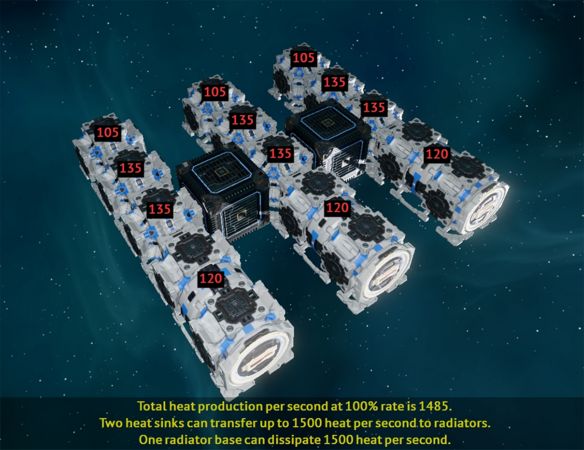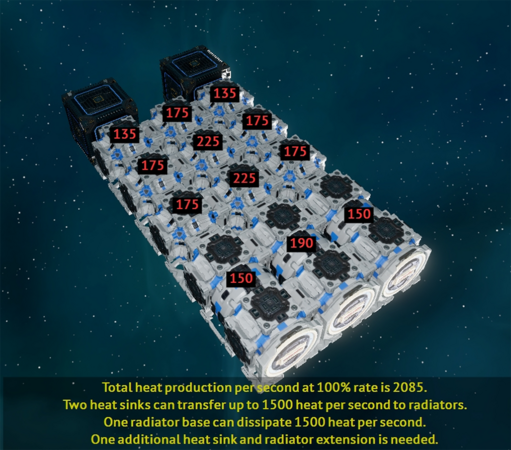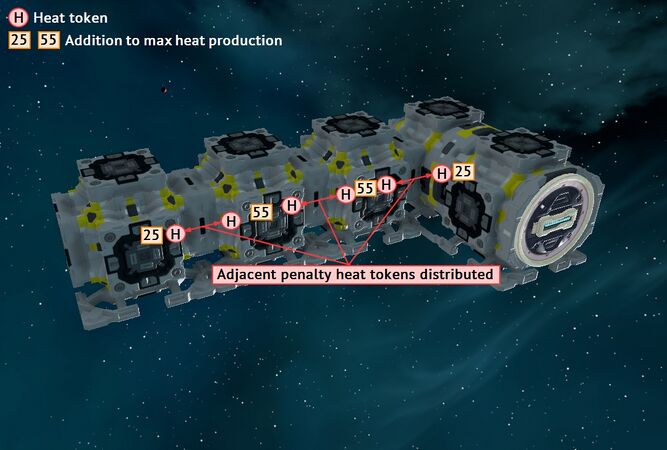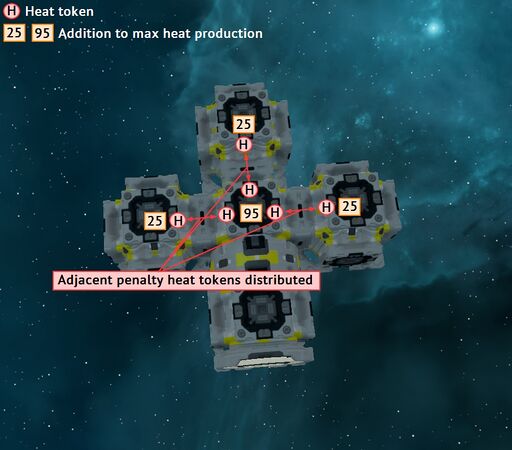Difference between revisions of "Heat mechanics"
m |
(Added a section with links to community made tools) |
||
| (22 intermediate revisions by 4 users not shown) | |||
| Line 1: | Line 1: | ||
{{Otherlang2 | {{Otherlang2 | ||
}}{{SB Infobox Begin | }}{{SB Infobox Begin | ||
|{{SB Infobox Header | |{{SB Infobox Header | ||
|image=[[Image: | |image=[[Image:Heatsinks group.png]] | ||
|factionLogo= | |factionLogo= | ||
|caption= | |caption=A collection of heatsinks | ||
|border=none | |border=none | ||
}} | }} | ||
}}'''Heat''' is a byproduct of the operation of many [[ | }}'''Heat''' is a byproduct of the operation of many [[devices and machines]], and must be dissipated to maintain peak efficiency. It is created primarily during the operation of [[Generator_(Assembly)|generators]] and [[mounted weapons]], and can be stored in a [[heatsink]], dissipated with [[Radiator|radiators]], or (in the case of generators) rapidly nullified with [[Small cooling cell|coolant cells]]. Devices are also capable of dispersing some small amount of heat by themselves, though it should not be relied upon as a viable thermal control for a ship. | ||
== Production of Heat == | == Production of Heat == | ||
Currently, only [[Generator_(Assembly)|generators]] and [[ | Currently, only [[Generator_(Assembly)|generators]] and [[mounted weapons]] produce heat that must be dispersed, the former of which produces a quantity of heat that is generally proportional to the amount of electricity it is producing (for example, tier 3 generator units produce both the highest amount of electricity and heat per unit as compared to other tiers of generator units). | ||
=== Effects of Proximity on Heat=== | === Effects of Proximity on Heat=== | ||
For [[Generator unit|generator units]], adjacency is an important consideration for a well-balanced system. Each device in an assembled generator ([[Fuel chamber|fuel chambers]], [[Enhancer|enhancers]], or even other generator units) will not only add its own heat to the equation, but will also insulate connected devices. This 'insulation' will increase the amount of heat that each directly adjacent device produces, proportional to the number of the devices that are contributing to the insulating effect. A well-designed generator assembly must take this into consideration, as densely packed generators will produce exponentially more heat per device when compared to those with isolated devices. | For [[Generator unit|generator units]], adjacency is an important consideration for a well-balanced system. Each device in an assembled generator ([[Fuel chamber|fuel chambers]], [[Enhancer|enhancers]], or even other generator units) will not only add its own heat to the equation, but will also insulate connected devices. This 'insulation' will increase the amount of heat that each directly adjacent device produces, proportional to the number of the devices that are contributing to the insulating effect. A well-designed generator assembly must take this into consideration, as densely packed generators will produce exponentially more heat per device when compared to those with isolated devices. | ||
<div style="display:flex;justify-content:center;"><gallery mode="packed-hover" caption="The effects of proximity on heat generation" widths=400px heights=300px> | <div id="adjacent-heat" style="display:flex;justify-content:center;"><gallery mode="packed-hover" caption="The effects of proximity on heat generation" widths=400px heights=300px> | ||
File:Heat Mechanics, Generator Layout 1.png | File:Heat Mechanics, Generator Layout 1.png | ||
File:Heat Mechanics, Generator Layout 2.png | File:Heat Mechanics, Generator Layout 2.png | ||
</gallery></div> | </gallery></div> | ||
=== | ==== Heat Tokens ==== | ||
The maximum amount of heat that any one device can produce is contingent upon a symbolic representation of data known as a '''Heat Token''': The more of these tokens that a device has associated with it, the higher the ''limit'' for maximum heat is raised, by a value that is specific to each device. Generators and fuel chambers will add a heat token to each device which it is connected to, thus raising the heat-producing potential of the system. Though a single device could conceivably have dozens of these heat tokens, it will only pass one on to each adjacent device. | |||
<div style="display:flex;justify-content:center;"><gallery mode="packed-hover" caption="Generator layouts with considerations made to address heat potential" widths=400px heights=300px> | |||
File:Heat tokens, 1.jpg | |||
File:Heat tokens, 2.jpg | |||
</gallery></div> | |||
Each component has a technical maximum of heat tokens which it can obtain, which is naturally proportional to the number of modular interfaces it has - however, enhancers will apply numerous heat tokens to the device. It is important to consider the placement of generator modules, as the effect of heat tokens increases exponentially with quantity (displayed below). | |||
{|class="wikitable mw-collapsible mw-collapsed" align="center" style="text-align:center;" | |||
! colspan=2 | Heat Token Count and the Associated Increase in Potential Heat | |||
|- | |||
!Heat Token Count | |||
!Effect on Maximum Heat Output | |||
|- | |||
|1 | |||
| +25 | |||
|- | |||
|2 | |||
| +55 | |||
|- | |||
|3 | |||
| +95 | |||
|- | |||
|4 | |||
| +145 | |||
|- | |||
|5 | |||
| +205 | |||
|- | |||
|6 | |||
| +275 | |||
|- | |||
|7 | |||
| +355 | |||
|- | |||
|8 | |||
| +445 | |||
|- | |||
|9 | |||
| +545 | |||
|- | |||
|10 | |||
| +655 | |||
|- | |||
|11 | |||
| +775 | |||
|- | |||
|12 | |||
| +905 | |||
|- | |||
|13 | |||
| +1,045 | |||
|- | |||
|14 | |||
| +1,195 | |||
|- | |||
|15 | |||
| +1,355 | |||
|- | |||
|16 | |||
| +1,525 | |||
|- | |||
|17 | |||
| +1,705 | |||
|- | |||
|18 | |||
| +1,895 | |||
|- | |||
|19 | |||
| +2,095 | |||
|- | |||
|20 | |||
| +2,305 | |||
|- | |||
|21 | |||
| +2,525 | |||
|- | |||
|22 | |||
| +2,755 | |||
|- | |||
|23 | |||
| +2,995 | |||
|- | |||
|24 | |||
| +3,245 | |||
|- | |||
|25 | |||
| +3,505 | |||
|} | |||
== Enhancers == | |||
[[Enhancer|Enhancers]] are used to quickly boost the rate of production of electricity in a generator unit by increasing the efficiency with which they utilize fuel, and can be easily turned on and off with [[YOLOL]]. However, while a generator unit with an attached and activated enhancer unit will produce significantly more electricity, it will also suffer an exponential increase in heat output. While an enhancer can be used to maximize power output (for as long as the cooling performance can keep up), it can also be used to boost efficiency at lower generation states, allowing the production of power at a comparatively lower fuel cost -- though, this will still generate extra heat. Enhancers affect the generation of heat by adding to the quantity of heat tokens held by the device to which they are attached. | |||
It should be noted that, though enhancers increase the heat potential of a generator system, enhancers themselves are unaffected by heat. | |||
{|class="wikitable mw-collapsible" align="center" style="text-align:center;" | |||
! colspan=3 | Enhancer Effects | |||
|- | |||
!Enhancer Tier | |||
!Heat Tokens | |||
!Electricity Production Tokens | |||
|- | |||
|Tier 1 | |||
| +3 | |||
| +1 | |||
|- | |||
|Tier 2 | |||
| +4 | |||
| +2 | |||
|- | |||
|Tier 3 | |||
| +5 | |||
| +3 | |||
|} | |||
The number of electricity production tokens a generator unit has directly affects the boost applied to its output, as shown below: | |||
{|class="wikitable mw-collapsible" align="center" style="text-align:center;" | |||
! colspan=3 | Electricity Production Tokens | |||
|- | |||
!Electricity Production Tokens | |||
!Electrical Output | |||
|- | |||
| 1 | |||
| +500 | |||
|- | |||
| 2 | |||
| +750 | |||
|- | |||
| 3 | |||
| +1,000 | |||
|} | |||
* '''Note''': Enhancers have traditionally been used on fuel rod chambers. However, when these mechanics are added to the live universe, enhancers will no longer have any effect when applied to fuel rod chambers. They will instead affect only generator units. | |||
== Dispersion of Heat == | == Dispersion of Heat == | ||
| Line 33: | Line 166: | ||
== YOLOL == | == YOLOL == | ||
All devices that produce heat have [[ | All devices that produce heat have [[device fields]] to monitor properties such as thermal load and storage. [[YOLOL]] plays a key role in the management of heat, as it can be used not only to monitor the generation and storage of heat in any particular device, but also to finely modulate the transfer of heat itself, be that by adjusting the transfer rate to or from a heatsink or radiator or by adjusting coolant flow from a coolant cell. With the proper YOLOL, all generator characteristics pertaining to heat management can be automatically maintained. | ||
== Heat-related Devices == | == Heat-related Devices == | ||
| Line 93: | Line 226: | ||
!Device | !Device | ||
!Heat Production <br/>(per shot) | !Heat Production <br/>(per shot) | ||
!Heat Production <br/>(sustained) | !Heat Production <br/>(sustained fire, per second) | ||
!Electricity Consumption <br/>(per shot) | !Electricity Consumption <br/>(per shot) | ||
!Electricity Consumption <br/>(sustained, per second) | !Electricity Consumption <br/>(sustained fire, per second) | ||
!Heat Storage | !Heat Storage | ||
!Heat Dissipation <br/>(per second) | !Heat Dissipation <br/>(per second) | ||
| Line 152: | Line 285: | ||
!Recharge Rate | !Recharge Rate | ||
|- | |- | ||
|Heat Sink, Beam Type | |[[Heatsink|Heat Sink, Beam Type]] | ||
|15,000 | |15,000 | ||
|50 | |50 | ||
| Line 160: | Line 293: | ||
|— | |— | ||
|- | |- | ||
|Heat Sink, Cube Type | |[[Heatsink|Heat Sink, Cube Type]] | ||
|15,000 | |15,000 | ||
|50 | |50 | ||
| Line 168: | Line 301: | ||
|— | |— | ||
|- | |- | ||
|Heat Sink, Plate Type | |[[Heatsink|Heat Sink, Plate Type]] | ||
|15,000 | |15,000 | ||
|50 | |50 | ||
| Line 179: | Line 312: | ||
|1,500 | |1,500 | ||
|1,500 | |1,500 | ||
| | |— | ||
|— | |— | ||
|— | |— | ||
| Line 186: | Line 319: | ||
|[[Radiator|Radiator Extension]] | |[[Radiator|Radiator Extension]] | ||
|1,500 | |1,500 | ||
| | |750 | ||
| | |— | ||
|— | |— | ||
|— | |— | ||
| Line 202: | Line 335: | ||
# ''Calculated total at maximum flow rate'' | # ''Calculated total at maximum flow rate'' | ||
# ''Small coolant cells will recharge on their own at a rate of 1 per second. However, when used with a [[Coolant recharge rack|coolant recharge rack]], this is boosted to 15 per second'' | # ''Small coolant cells will recharge on their own at a rate of 1 per second. However, when used with a [[Coolant recharge rack|coolant recharge rack]], this is boosted to 15 per second'' | ||
[[ | |||
== External Tools == | |||
Listed below are several community made tools which may be useful for calculating heat and designing a generator. | |||
* [https://dead.earth/ Greebo's Heat Helper] - A 3D Heat calculator tool | |||
* [https://docs.google.com/spreadsheets/d/1HduL3DGFwAtNKY64-IK7pw7uZeZvDGUnT6q17jD7r6c Duke's Generator Coolant Usage Sheet] - A device requirements helper Spreadsheet | |||
Latest revision as of 22:36, 5 May 2022
Heat is a byproduct of the operation of many devices and machines, and must be dissipated to maintain peak efficiency. It is created primarily during the operation of generators and mounted weapons, and can be stored in a heatsink, dissipated with radiators, or (in the case of generators) rapidly nullified with coolant cells. Devices are also capable of dispersing some small amount of heat by themselves, though it should not be relied upon as a viable thermal control for a ship.
Production of Heat
Currently, only generators and mounted weapons produce heat that must be dispersed, the former of which produces a quantity of heat that is generally proportional to the amount of electricity it is producing (for example, tier 3 generator units produce both the highest amount of electricity and heat per unit as compared to other tiers of generator units).
Effects of Proximity on Heat
For generator units, adjacency is an important consideration for a well-balanced system. Each device in an assembled generator (fuel chambers, enhancers, or even other generator units) will not only add its own heat to the equation, but will also insulate connected devices. This 'insulation' will increase the amount of heat that each directly adjacent device produces, proportional to the number of the devices that are contributing to the insulating effect. A well-designed generator assembly must take this into consideration, as densely packed generators will produce exponentially more heat per device when compared to those with isolated devices.
Heat Tokens
The maximum amount of heat that any one device can produce is contingent upon a symbolic representation of data known as a Heat Token: The more of these tokens that a device has associated with it, the higher the limit for maximum heat is raised, by a value that is specific to each device. Generators and fuel chambers will add a heat token to each device which it is connected to, thus raising the heat-producing potential of the system. Though a single device could conceivably have dozens of these heat tokens, it will only pass one on to each adjacent device.
Each component has a technical maximum of heat tokens which it can obtain, which is naturally proportional to the number of modular interfaces it has - however, enhancers will apply numerous heat tokens to the device. It is important to consider the placement of generator modules, as the effect of heat tokens increases exponentially with quantity (displayed below).
| Heat Token Count and the Associated Increase in Potential Heat | |
|---|---|
| Heat Token Count | Effect on Maximum Heat Output |
| 1 | +25 |
| 2 | +55 |
| 3 | +95 |
| 4 | +145 |
| 5 | +205 |
| 6 | +275 |
| 7 | +355 |
| 8 | +445 |
| 9 | +545 |
| 10 | +655 |
| 11 | +775 |
| 12 | +905 |
| 13 | +1,045 |
| 14 | +1,195 |
| 15 | +1,355 |
| 16 | +1,525 |
| 17 | +1,705 |
| 18 | +1,895 |
| 19 | +2,095 |
| 20 | +2,305 |
| 21 | +2,525 |
| 22 | +2,755 |
| 23 | +2,995 |
| 24 | +3,245 |
| 25 | +3,505 |
Enhancers
Enhancers are used to quickly boost the rate of production of electricity in a generator unit by increasing the efficiency with which they utilize fuel, and can be easily turned on and off with YOLOL. However, while a generator unit with an attached and activated enhancer unit will produce significantly more electricity, it will also suffer an exponential increase in heat output. While an enhancer can be used to maximize power output (for as long as the cooling performance can keep up), it can also be used to boost efficiency at lower generation states, allowing the production of power at a comparatively lower fuel cost -- though, this will still generate extra heat. Enhancers affect the generation of heat by adding to the quantity of heat tokens held by the device to which they are attached.
It should be noted that, though enhancers increase the heat potential of a generator system, enhancers themselves are unaffected by heat.
| Enhancer Effects | ||
|---|---|---|
| Enhancer Tier | Heat Tokens | Electricity Production Tokens |
| Tier 1 | +3 | +1 |
| Tier 2 | +4 | +2 |
| Tier 3 | +5 | +3 |
The number of electricity production tokens a generator unit has directly affects the boost applied to its output, as shown below:
| Electricity Production Tokens | ||
|---|---|---|
| Electricity Production Tokens | Electrical Output | |
| 1 | +500 | |
| 2 | +750 | |
| 3 | +1,000 | |
- Note: Enhancers have traditionally been used on fuel rod chambers. However, when these mechanics are added to the live universe, enhancers will no longer have any effect when applied to fuel rod chambers. They will instead affect only generator units.
Dispersion of Heat
All heat-producing devices have a specific heat capacity which allows it to buffer heat generated from itself or adjacent devices, much like a battery can store electricity. These devices can also radiate some small amount of heat on their own, providing a constant passive cooling rate. Though this effect is constant, heat must be managed via the ship's pipe network, and be transferred to a heatsink, radiator, or cooling cell in order to be effectively dissipated. However, these devices can only transfer a small portion of their generated heat directly to a radiator, after which point the heat will begin to accumulate in the device's heat capacity. A heatsink must instead be utilized to capture the excess heat, as these devices have both a very high heat capacity as well as the ability to transfer vastly more thermal energy to a radiator than any other device could. After heat has been transferred (whether it be directly or via a heatsink), it can be dissipated extremely quickly by the radiator.
Thermal Soak
As mentioned before, all devices have a certain capacity for heat, which can be filled up by its own operation or by the operation of devices connected to it. Once this capacity has been saturated, the device will overheat and shutdown until the heat stored within it has been managed. Since all heat-producing devices can dissipate some amount of heat on their own and have this specific amount of heat capacity, many devices can be operated without being dependent on a dedicated cooling system. However, this naturally comes at the caveat of putting an extreme limitation on the usage of the device in question: Generators will only be able to produce electricity at a fraction of their normal operating capacity, and weapons will only be able to fire periodically (if at all).
YOLOL
All devices that produce heat have device fields to monitor properties such as thermal load and storage. YOLOL plays a key role in the management of heat, as it can be used not only to monitor the generation and storage of heat in any particular device, but also to finely modulate the transfer of heat itself, be that by adjusting the transfer rate to or from a heatsink or radiator or by adjusting coolant flow from a coolant cell. With the proper YOLOL, all generator characteristics pertaining to heat management can be automatically maintained.
Producing Heat
Power Generation
| Device | Heat Production (maximum, per second) |
Heat Storage | Heat Dissipation (per second) |
Transfer Rate (to radiator, per second) |
Transfer Rate (to heatsink, per second) |
|---|---|---|---|---|---|
| Generator Unit (Tier 1) | 80 | 1,500 | 5 | 75 | 1,500 |
| Generator Unit (Tier 2) | 90 | 1,500 | 5 | 75 | 1,500 |
| Generator Unit (Tier 3) | 100 | 1,500 | 5 | 75 | 1,500 |
| Fuel Chamber (Tier 1) | 95 | 1,500 | 5 | 30 | 1,500 |
| Fuel Chamber (Tier 2) | 95 | 1,500 | 5 | 30 | 1,500 |
| Fuel Chamber (Tier 3) | 80 | 1,500 | 5 | 30 | 1,500 |
Ship Weapons
| Device | Heat Production (per shot) |
Heat Production (sustained fire, per second) |
Electricity Consumption (per shot) |
Electricity Consumption (sustained fire, per second) |
Heat Storage | Heat Dissipation (per second) |
Transfer Rate (to radiator, per second) |
Transfer Rate (to heatsink, per second) |
|---|---|---|---|---|---|---|---|---|
| Autocannon | 125 | 1,000 | 94 | 1,002 | 1,000 | 10 | 50 | 1,000 |
| Laser Cannon | 80 | 500 | 440 | 3,000 | 1,000 | 10 | 50 | 1,000 |
| Plasma Cannon | 800 | 941 | 2,000 | 2,603 | 1,000 | 10 | 50 | 1,000 |
| Rail Cannon | 600 | 336 | 20,000 | 12,700 | 1,000 | 10 | 50 | 1,000 |
Dissipating Heat
| Device | Heat Storage | Heat Dissipation (max, per second) |
Transfer Rate (to radiator, per second) |
Coolant Capacity | Coolant Transfer (to generator, per second) |
Recharge Rate |
|---|---|---|---|---|---|---|
| Heat Sink, Beam Type | 15,000 | 50 | 750 | — | — | — |
| Heat Sink, Cube Type | 15,000 | 50 | 750 | — | — | — |
| Heat Sink, Plate Type | 15,000 | 50 | 750 | — | — | — |
| Radiator Base | 1,500 | 1,500 | — | — | — | — |
| Radiator Extension | 1,500 | 750 | — | — | — | — |
| Cooling Rack | — | 25,000 [1] | — | 10,000 * 3 | 5,000 | 1 / 15 [2] |
- Calculated total at maximum flow rate
- Small coolant cells will recharge on their own at a rate of 1 per second. However, when used with a coolant recharge rack, this is boosted to 15 per second
External Tools
Listed below are several community made tools which may be useful for calculating heat and designing a generator.
- Greebo's Heat Helper - A 3D Heat calculator tool
- Duke's Generator Coolant Usage Sheet - A device requirements helper Spreadsheet




